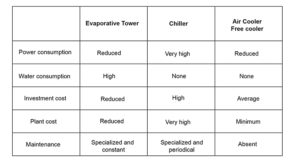Thermal cooling energy costs comparison
We are now able to make a comparison among three different cooling systems based upon their power consumption: evaporative tower, chiller (air or water condensed) and air cooler/free cooler.
- The chiller is the most expensive solution in terms of energy consumption: the compressors in the system absorb a huge amount of energy while, being equal the thermal duty and the type of production process, the other two solutions require power consumption only for fans and circulating pumps, as compressors are not required. On the other hand, chillers allow to obtain water at much lower temperatures, even very much lower, throughout the whole year.
- An evaporative tower is the less expensive solution, but its thermal performances are strictly linked to the environmental and weather conditions of wet bulb temperature. It also involves a demanding maintenance, due to the prevention, consumption and treatment of the water.
- The air cooler, or free cooler, allows a significant energy saving compared to a chiller, and doesn’t involve the maintenance issues of an evaporative tower because it works with a completely closed circuit. Maintenance needs are thus limited to a periodical cleaning of the thermal exchange pack. But once again, the thermal performance is linked to weather and seasonal conditions.

Being things as above, a combined system chiller + free cooling, which ensure the thermal process during the winter season shutting down chillers, results as the best performing solution, less expensive and less demanding in terms of maintenance, in addition to a higher energy saving outcome, especially when the thermal cooling achieved by the free cooler is prolonged. In order to further increase the efficiency in terms of energy saving, is it also possible to implement some wise tricks, allowing to extend the operations of the free cooling section also during the hot season, thanks to an adiabatic boosting of the system.



 Back to index
Back to index Download the complete book
Download the complete book